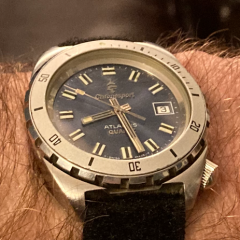Broken barrel arbor.
-
Recently Browsing
- No registered users viewing this page.
-
Topics
-
Posts
-
By Latetothegame · Posted
I recently posted about my inability to determine exactly how to open a vintage Sovereign watch. As some of you may recall, with a lot of help from people in this group, I eventually figured out that the watch was a front loader and got everything worked out. The watch is now running great and in my collection. For my very next project I purchased a 1950s Benrus 3 Star 25 Jewel Self-Winding watch. I wanted to expand my experience into automatics. I figured since Sovereign was made by Benrus and both leaned heavily into front loading single piece case backs, I shouldn’t have a problem. I was wrong. Let me try to get to the point. I have added pictures to help provide as much info as possible. This watch appears to clearly have a seam in the case back. There seems to be an opening on the rear of the front half of the case to allow the stem to slide out of the back of the case (possibly without being removed). The case DOES NOT say “Open Through Crystal” as many Benrus watches do. The crystal is a “low dome” style and my crystal lift (not the highest quality )cannot seem to get a grip on the side of it as it is almost 100% angled with no real straight piece to grasp. I read in an old discussion on this site (where someone was having a similar issue) that some Benrus watches open by pushing the crystal and movement through the case in a way that actually pushed the case back off. I can find NO obvious place intended for prying the case back off but there definitely appears to be a seam. See pics. Once again, I would greatly appreciate your input and advice. Thanks. -
@mikepilk - yes, this is a cheap movement and I have a donor movement with balance intact if all goes wrong with the tweak. I’d leave it alone if it were anything irreplaceable. That’s why I thought it would be good for practice 🙂 This balance self-starts when winding from zero, so clearly a 2ms BE isn’t high enough to prevent that. I’d be tweaking it for sure if didn’t. In fact, that’s exactly the reason I needed to adjust the BE of the last movement with a fixed stud I serviced - it had trouble starting at a low wind and without shaking it. @Nucejoe - thanks for the tip. I’ll give the hairspring a prod while running on the TG - gently - this afternoon.
-
By HectorLooi · Posted
Thanks @nevenbekriev. I've been using a mini hacksaw to cut off my work pieces. I see you mounted your cutters on their own holders, made of angled steel. Clever! I bought the smallest quick change tool post available but when mounted on the cross slide, it is much too big. How did you drill through the head of the bolt? -
I guess to figure out what you were getting at John you'd have to be clever!? 😉 I would expect a higher amplitude and we can't get enough of that, can we? 😉 Also, it will be easier to get the balance going once it stops and we wind the mainspring up from 0. I haven't personally investigated if that's true but it sounded reasonable when Kalle Slaap described it. Maybe the difference is negligible when the beat error is 2.0ms or less?
-
Slightly tweak to push the coil to one side, push right after the bend of terminal curve, you can actually see the balance rotate a bit . Do this with the movement on TG while running, observe !! see if BE get smaller or wider. If BE gets bigger , your beat was advance, and vice versa. ---Slight push is so you don't cause a permanent bend , you want the coil to bounce back unbent. https://redirect.viglink.com/?format=go&jsonp=vglnk_171969890606813&key=7384788ce4aeab830f00b905bbcc0552&libId=ly0qhzdj010050gq000ULau7hbs8i&loc=https%3A%2F%2Frwg.cc%2Ftopic%2F188093-yuki-3135-hairspring%2F&v=1&opt=true&out=http%3A%2F%2Fimg.timezone.com%2Fimg%2Farticles%2Fhorologium631675494030170118%2Fmark12-2.reg.schematic.numbered.jpg&ref=https%3A%2F%2Fwww.google.com%2F&title=Yuki 3135 hairspring - General Discussion - RWG&txt= Tweak section one. Good luck
-






Recommended Posts
Join the conversation
You can post now and register later. If you have an account, sign in now to post with your account.
Note: Your post will require moderator approval before it will be visible.